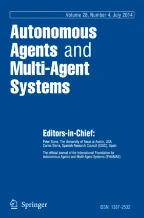Abstract
We propose an operational model that combines message meaning and conversational structure in one comprehensive approach. Our long-term research goal is to lay down principles uniting message meaning and conversational structure while providing an operational foundation that could be implemented in open computer systems. In this paper we explore our advances in one aspect of meaning that in theories of language use is known as “signal meaning”, and propose a layered model in which the meaning of messages can be defined according to their fitness to advance the state of joint activities. Messages in our model are defined in terms of social commitments, which have been shown to entice conversational structure.
Similar content being viewed by others
Explore related subjects
Discover the latest articles, news and stories from top researchers in related subjects.References
Castelfranchi, C. (1995). Commitments: From individual intentions to groups and organizations. In Proceedings of the first international conference on multi-agent Systems, June 1995, (pp. 41–48), San Francisco, CA.
Chaib-draa B., Labrie M-A., Bergeron M. and Pasquier P. (2006). DIAGAL: An agent communication language based on dialogue games and sustained by social commitments. Autonomous Agents and Multi-Agent Systems 13(1): 61–95
Clark, H. H. (1996). Using language. Cambridge University Press.
Craig, R. T., & Tracy, K. (1983). Conversational coherence: Form, structure, and strategy. Sage Publications.
Diller A. (1990). Z: An introduction to formal methods. John Wiley & Sons, Inc, Sussex, England
Flores R.A. and Kremer R.C. (2003). To commit or not to commit: Modelling agent conversations for action. Computational Intelligence 18(2): 120–173
Flores, R. A., & Kremer, R. C. (2004). A principled modular approach to construct flexible conversation protocols. In A. Y. Tawfik, & S. D. Goodwin (Eds.), Advances in Artificial Intelligence: Canadian AI 2004, Lecture Notes in Computer Science (Vol. 3060, pp. 1–15). May 2004. Springer Verlag.
Flores, R. A., Pasquier, P., & Chaib-draa, B. (2006). What do agents commit to do when they commit to something? Work in progress.
Fornara, N., Vigano, F., & Colombetti, M. Agent communication and institutional reality. Autonomous Agents and Multi-Agent Systems, forthcoming.
Kagal, L., & Finin, T. Modeling communicative behavior using permissions and obligations. Autonomous Agents and Multi-Agent Systems, forthcoming.
Kremer, R. C., & Flores, R. A. (2005). Using a performative subsumption lattice to support commitment-based conversations. In Proceedings of the fourth international joint conference on autonomous agents and multiagent systems, July 2005, Utrecht, The Netherlands.
Mallya, A. U., & Singh, M. P. A semantic approach for designing commitment protocols. Autonomous Agents and Multi-Agent Systems, forthcoming.
Parsons, S., McBurney, P., & Wooldridge, M. J. (2004). The mechanics of some formal inter-agent dialogues. In F. Dignum (Ed.), Advances in agent communication, Lecture Notes in Artificial Intelligence (Vol. 2922, pp. 329–348). Springer Verlag.
Pasquier, P., Flores, R. A., & Chaib-draa, B. (2004). Modelling flexible social commitments and their enforcement. In M. P. Gleizes, A. Omicini, & F. Zambonelli (Eds.), Fifth international workshop on engineering societies in the agents world, Lecture Notes in Artificial Intelligence (Vol. 3451, pp. 153–165) Tolouse, France, October 2004. Springer Verlag.
Pitt J. and Mamdani A. (1999). Some remarks on the semantics of FIPAs agent communication language. Autonomous Agents and Multi-Agent Systems 2(4): 333–356
Reed, C. A. (1998). Dialogue frames in agent communication. In Proceedings of the third international conference on multiagent systems (ICMAS 98) (pp. 246–253). Paris, France: IEEE Press.
Singh, M. P. (1991). Social and psychological commitments in multiagent systems. In AAAI fall symposium on knowledge and action at social and organizational levels, November 1991, Monterey, California.
Singh M.P. (1998). Agent communicational languages: Rethinking the principles. IEEE Computer 31(12): 40–47
Sirbu M. (1997). Credits and debits on the Internet. IEEE Spectrum 34(2): 23–29
Smith, G. (2000). The object-Z specification language. Kluwer Publishers.
Walton, D. N., & Krabbe, E. C. W. (1995). Commitment in dialogue: Basic concepts of interpersonal reasoning. State University of New York Press.
Author information
Authors and Affiliations
Corresponding author
Rights and permissions
About this article
Cite this article
Flores, R.A., Pasquier, P. & Chaib-draa, B. Conversational semantics sustained by commitments. Auton Agent Multi-Agent Syst 14, 165–186 (2007). https://doi.org/10.1007/s10458-006-0011-1
Published:
Issue Date:
DOI: https://doi.org/10.1007/s10458-006-0011-1

